Restoring Damaged Text – The C.G. Boxall Memorial
by B. van Cleve
The year 2024 marked the bicentennial of St. Peter’s Church in Brighton. Among the associated projects was the recording of commemorative inscriptions found throughout the building. Despite their age, most remain in pristine condition, but one, a stone commemorating Sir Charles Gervaise Boxall, KCB, has suffered extensive damage. Part of the text can be deciphered, albeit with difficulty, but the remainder appeared, on initial inspection, to be completely illegible.

An older, undated photo and a rendering of the text can be found on the website of the Imperial War Museum (text has been updated since our initial visit to the website, see below). On that photo, some text passages can be discerned that are today completely destroyed. However, the text initially provided by the IWM may be based, at least in part, on even earlier sources, as some words that are illegible even on the historic photo are shown as intact by the IWM, without any indication of a reconstruction.

The undated photo from the IWM website (© WMR-43421)
While the text initially published by the IWM was consistent and appeared sound, the reconstructions did not always fit convincingly into the spaces provided by the lacunae (spaces created by damage) on the memorial. In addition, substantial gaps remained that we hoped to close at least in part.
In an attempt to achieve the best possible reconstruction of the text on the plaque, it was scrutinized line by line, taking into account the restoration initially provided by the Imperial War Museum, the historic photo, our own high-resolution images from 2024, and historic documentation of the life of Sir Charles.

Line 1: The Text is fully legible.

Line 2: The abbreviation ‘K.C.B.’ is damaged, but the reconstruction is secure as Boxall’s rank and title as Knight Commander of the Order of the Bath are confirmed by historic sources.

Line 3: The original text of the IWM agreed with the historic photo. Some letters have since become harder to discern. The last letter of the word ‘EDUCATED’ and the words ‘AT BRIGHTON’ were already damaged in the photo, but the reconstruction remains straightforward so far. The only problem is Boxall’s year of birth, clearly legible as 1852. Historical sources strongly suggest that Boxall was actually born in 1851. We follow the text of the monument:


IWM: COLLEGE HE ACHIEVED DISTINCTION IN MORE THAN (….)IELD
Line 4: The first 6 words are clearly legible and were accurately rendered by the IWM. The IWM then adds the word ‘THAN’, which is not present on the historic photo, nor could we make it visible with high resolution images. Assuming that it was still legible when the IWM recorded the text, very little space remains for the missing letters between ‘THAN’ and ‘IELD’. The context suggests that a written number should follow the phrase ‘MORE THAN’, with space for three letters, since ‘IELD’ needs at least one leading letter to become a word. Numbers spelled with three letters are ‘one’, ‘two’, ‘six’, and ‘ten’, but since the following word stands without a plural ending, ‘ONE’ is the only valid option. Regarding the following fragment, ‘FIELD’ and ‘YIELD’ are the only two ways to achieve a proper word, with ‘FIELD’ alone making sense in the context. The resulting text would read: ‘COLLEGE HE ACHIEVED DISTINCTION IN MORE THAN ONE FIELD’. This constitutes the first resolution of a lacuna, compared to the older rendering. The original text is believed to have read


IWM: A PROMINENT MEMBER OF THE LEGAL PROFESSION HE (…)
Line 5: The text of the IWM and the historic photo agree on the first 7 words. ‘HE’ is no longer legible in the photo, only some traces of the lower parts of the letters can be discerned. The words that follow were not recognized in the IWM reconstruction, despite the fact that the historic photo clearly shows ‘IEUT–’ as the final letters of the line. ‘EUT–’ can still be made out in recent images, as can be seen in the image below. Additionally, some lower parts of letters can be discerned between the ‘N’ of ‘PROFESSION’ and ‘IEUT–‘.

The first group of partly visible letters clearly belong to the word ‘HE’, which was still visible when the IWM text copy was collated. The next partly preserved letter is hard to interpret as anything other than ‘B’ (enlarged on the left in the image below).

The text would therefore have read: ‘A PROMINENT MEMBER OF THE LEGAL PROFESSION HE B…….IEUT–‘. The last word is an abbreviation of the rank of ‘Lieutenant’ that was in common use at the time. We know from other sources that Boxall at some point held the rank of a Lieutenant-Colonel. It is therefore plausible that line 5 once read: ‘A PROMINENT MEMBER OF THE LEGAL PROFESSION HE BECAME LIEUT–‘. The space available in line 5 would also support this reconstruction, the proposed original appearing as:


IWM: COLONEL COMMANDING 1ST SUSSEX YEOMANRY AND
Line 6: Line six presents us with the first serious lacuna. On the photo, the first letter following ‘SUSSEX’ is clearly visible as a ‘V’. A close-up photo of the area confirms this, but it also reveals the lower parts of the three following letters.

The third of these is unmistakably a ‘U’, as becomes clear when compared to the ‘U’ in ‘LIEUT–‘ in line 5. The straight vertical line on the right side of the letter, running almost all the way to the bottom of the line, is diagnostic as it occurs in no other letter with a rounded lower edge. Not even the ‘C’ or the ‘G’ have it in this distinct form. From historical sources we also know that Boxall was involved with a unit frequently referred to as the Volunteer Artillery. Looking closer at the two letters following the ‘V’, the lower parts still visible are compatible with an ‘O’ and an ‘L’. As such, the word is read here as ‘VOLUNTEER’. On the historic photo the last letters before the clearly visible ‘AND’ look very much like ‘RY’. This allows for a confident reconstruction as ‘VOLUNTEER ARTILLERY’. When letters from the plaque are copied and laid over the missing part of line 6, the words ‘VOLUNTEER ARTILLERY’ fit well into the space available. The original text of line 6 was therefore in all likelihood:


Line 7: The first 5 words of this line are fully present. However, the following text is almost entirely illegible and apparently was in that state when the IWM first copied the text on the plaque. What can be made out is that the line ends with the upper part of an ‘S’, followed by the clearly visible abbreviation ‘R.F.A.’

In addition, one can discern what looks like the first stroke of the letter ‘M’ above ‘LON’ in the following line (the slanting line can only belong to an ‘M’ or an ‘A’, although ‘M’ yields a better fit). The historical photo shows an additional ‘T’ and an ‘E’ just before the ‘S’, but those are no longer present. Historical sources state that Boxall had been Honorary Colonel of the 1st Home Counties R.F.A. Overlaying the historical photo with this putative text yields a perfect fit. The original text is therefore probably to be reconstructed as: AFTERWARDS HONORARY COLONEL OF THE 1ST HOME COUNTIES R.F.A


Line 8: The text on the historical photo is slightly damaged in places, with recent images showing increased deterioration. However, the affected words, ‘CHIEF’, and ‘LONDON’, remain fully legible.

Line 9: The words VOLUNTEERS RAISED AND EQUIPPED BY VOLUNTARY (…) TO TAKE are instantly recognizable. ‘VOLUNTARY’ is then followed by two destroyed letters and the upper part of what must be an ‘E’ or an ‘F’, followed by ‘ORT’. ‘E’ would not have yielded a valid word, leaving ‘F’. The text can then be reconstructed as ‘VOLUNTEERS RAISED AND EQUIPPED BY VOLUNTARY EFFORT TO TAKE’, if the two missing letters are complemented as ‘EF’. The expression ‘VOLUNTARY EFFORT’ would also correspond with common usage at the time this plaque was created. We therefore suggest that the original text once read:


Line 10: The first 8 words of this line are clear. They are followed by lacunae that extend to the last word of the line, which is ‘PATRIOTIC’. The historical photo clearly shows the letters ‘AN’ after ‘FOR THIS’, and then, after a small lacuna, the remainders of an ‘O’ and a ‘T’, followed by a second lacuna. This suggests that missing text could be completed as ‘AND OTHER’. The line would have read: ‘PART IN THE SOUTH AFRICAN WAR .. FOR THIS AND OTHER PATRIOTIC’. Overlaying this text on the historical image yields a perfect fit. As such, we suggest that the text originally read:


Line 11: The first two thirds of text are well preserved. Regarding the following fragment ‘LIE’, the word ‘Lieutenant’ was abbreviated to ‘LIEUT-‘ in line 5, therefore the same abbreviation is likely present here as well. In addition, one can just make out what looks like a mutilated ‘ONEL’ before ‘IN’. Historical sources state that Boxall at some point held the rank of Lieutenant Colonel. This yields the text, ‘SERVICES HE WAS APPOINTED AN HONORARY LIEUT- COLONEL IN THE’. Overlaying ‘LIEUT- COLONEL IN’, it fits perfectly into the available space. We therefore suggest that the original once read:


Line 12: Apart from the second last word, text is fully legible here. In the historical photo, the first two letters of the missing word are visible as ‘MO’. The closeup below shows clear traces of ‘M’ and ‘O’ as well. As the official name of the order mentioned here is

‘The Most Honourable Order of the Bath’, line 12 is reconstructed as ‘ARMY AND CREATED A KNIGHT COMMANDER OF THE MOST HONOURABLE’, which would have appeared as:


Line 13: The first 6 words in this line are clearly visible on the photo. After that, the location of Boxall’s death is only partly legible, as ‘HTON’. Since it is on record that Boxall died in Brighton, a reconstruction as ‘IN BRIGHTON’ is straightforward. The year of his death is lost on the historical photo, and no traces of numbers could be made visible on close-up images. Historical sources confirm that Boxall died in 1914, yielding the text, ‘ORDER OF THE BATH. HE DIED IN BRIGHTON ON MARCH 6TH 1914’. Line 13 would (omitting the year, for which we do not have a font) originally have appeared as:



Line 14: Two words are hard to make out, but both are partly discernable. Traces of a letter ‘E’ are present, even on recent images, and the letters ‘RIBERE’ are legible in the historic photo and still so in recent images. The line seems to be from the works of Horace and quoted as: ‘ET JUSTUM POTERAS ET SCRIBERE FORTEM’.
In context, the complete sentence in Horace reads: ‘Attamen et iustum poteras et scribere fortem, Scipiadam ut sapiens Lucilius’, which is translated: ‘Yet, you could write about him as both just and courageous, as the wise Lucilius did about Scipio’.


Line 15: This final line is well preserved, by comparison. Only the words ‘HIS FRIENDS’ and ‘ARMS’ have now become partly illegible, compared to the historic photo. Of the phrase ‘HIS FRIENDS’, only the ‘H’ of ‘HIS’ and the ‘R’ of ‘FRIENDS’ remain.
Implementing the suggestions stated above, the entire reconstructed text would read as follows :

TO THE MEMORY OF
COLONEL SIR CHARLES GERVAISE BOXALL K.C.B.
BORN IN SUSSEX IN 1852 AND EDUCATED AT BRIGHTON
COLLEGE HE ACHIEVED DISTINCTION IN MORE THAN ONE FIELD
A PROMINENT MEMBER OF THE LEGAL PROFESSION HE BECAME LIEUT-
COLONEL COMMANDING THE 1ST SUSSEX VOLUNTEER ARTILLERY AND
AFTERWARDS HONORARY COLONEL OF THE 1ST HOME COUNTIES R.F.A
HE WAS THE CHIEF ORGANIZER OF THE CITY OF LONDON IMPERIAL
VOLUNTEERS RAISED AND EQUIPPED BY VOLUNTARY EFFORT TO TAKE
PART IN THE SOUTH AFRICAN WAR .. FOR THIS AND OTHER PATRIOTIC
SERVICES HE WAS APPOINTED AN HONORARY LIEUT-COLONEL IN THE
ARMY AND CREATED A KNIGHT COMMANDER OF THE MOST HONOURABLE
ORDER OF THE BATH . HE DIED IN BRIGHTON ON MARCH 6TH 1914
ET JUSTUM POTERAS ET SCRIBERE FORTEM
THIS STONE IS SET UP BY MANY OF HIS FRIENDS AND COMRADES IN ARMS
This reconstruction has since been adopted by the Imperial War Museum.
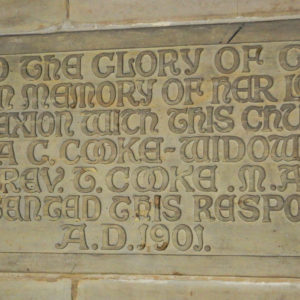
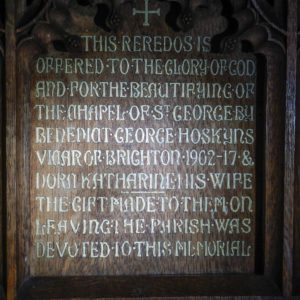
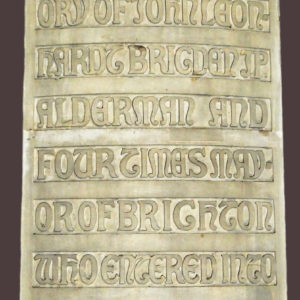
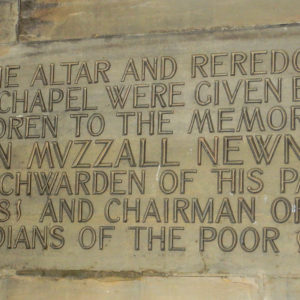
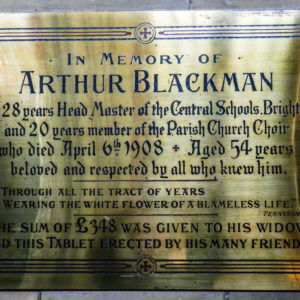
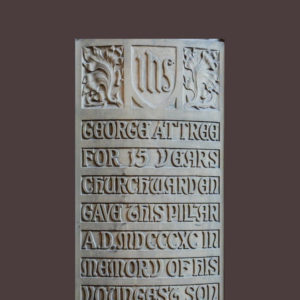

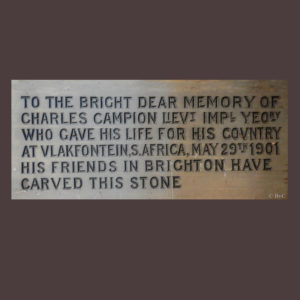
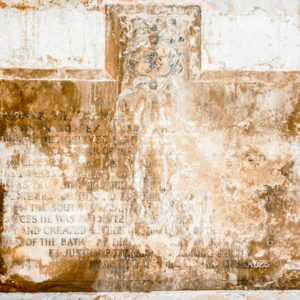
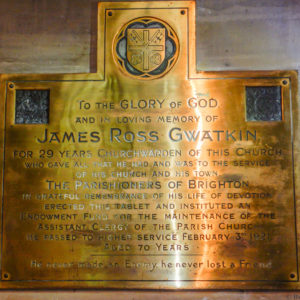
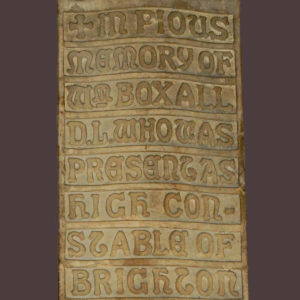

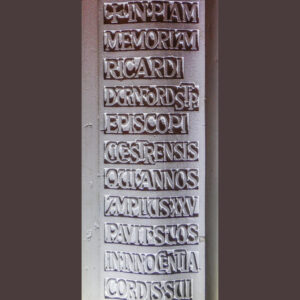
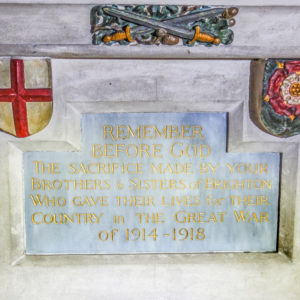
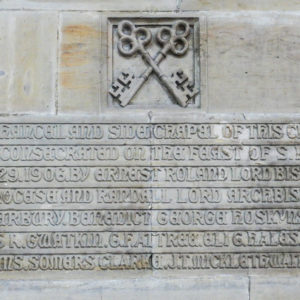
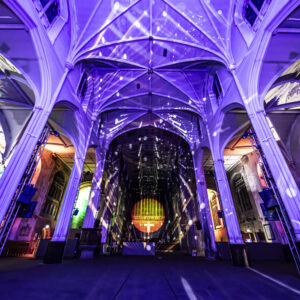

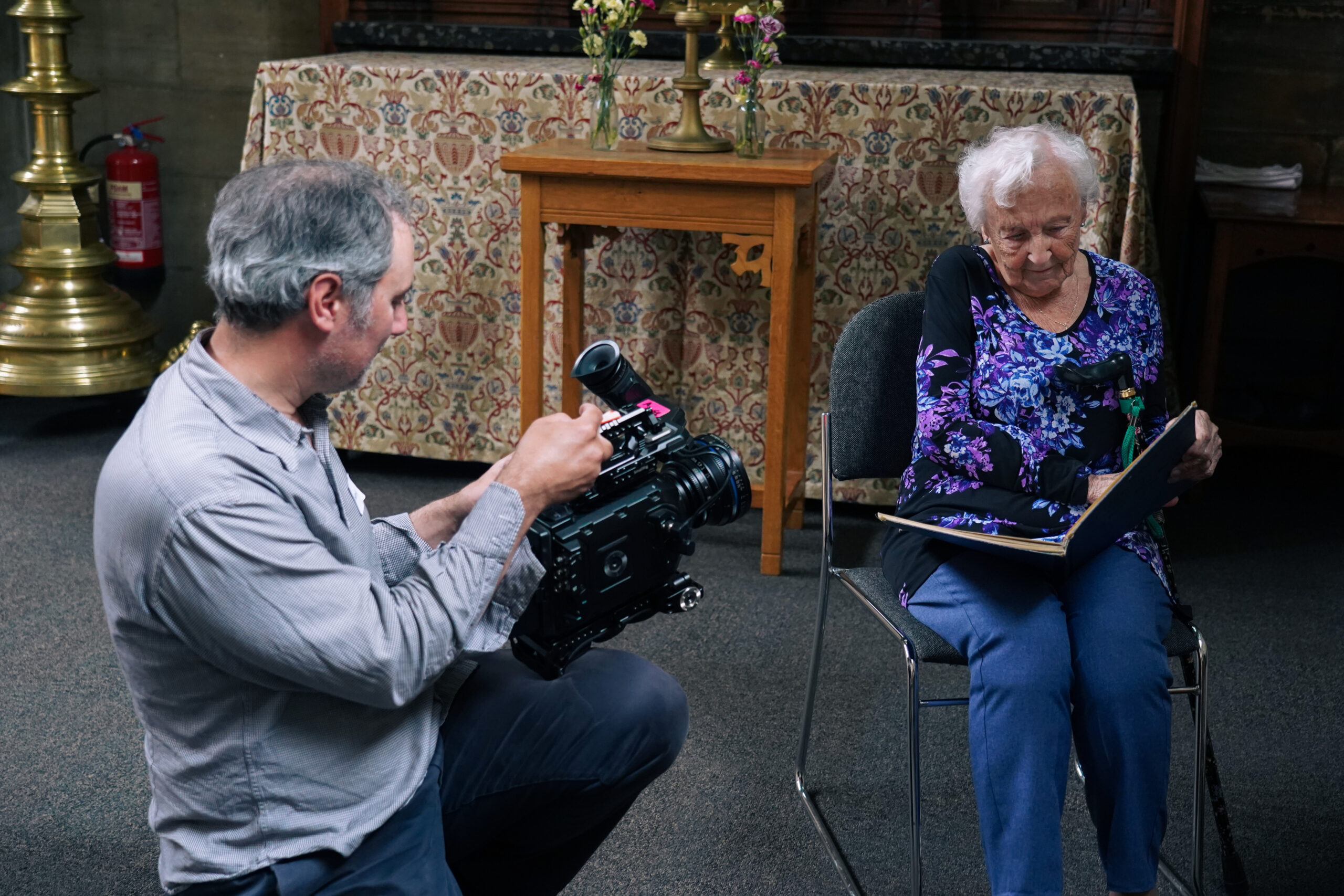



‘This project is kindly funded by Historic England as part of the Everyday Heritage - Working Class Histories. We are grateful to them for this funding.’